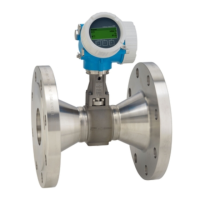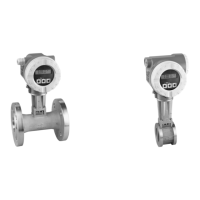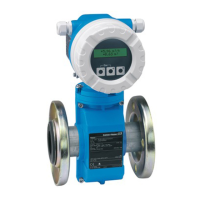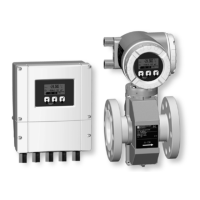Proline Prowirl R 200 HART Commissioning
Endress+Hauser 113
Parameter overview with brief description
Parameter Prerequisite Description Selection / User
entry
Factory setting
Inlet configuration The inlet run correction
feature:
• Is a standard feature and
can only be used in Prowirl F
200.
• Can be used for the
following pressure ratings
and nominal diameters:
DN 15 to 150 (1 to 6")
– EN (DIN)
– ASME B16.5, Sch. 40/80
Select inlet configuration. • Off
• Single elbow
• Double elbow
• Double elbow 3D
• Reduction
Off
Inlet run The inlet run correction
feature:
• Is a standard feature and
can only be used in Prowirl F
200.
• Can be used for the
following pressure ratings
and nominal diameters:
DN 15 to 150 (1 to 6")
– EN (DIN)
– ASME B16.5, Sch. 40/80
Define length of the straight
inlet run.
Dependency
The unit is taken from the
Length unit parameter
0 to 20 m 0 m
Mating pipe diameter – Enter diameter of mating pipe
to enable diameter mismatch
correction.
Detailed information on
diameter mismatch correction:
→ 113
Dependency
The unit is taken from the
Length unit parameter.
0 to 1 m (0 to 3 ft)
Input value = 0:
Diameter mismatch
correction is disabled.
Country-specific:
• 0 m
• 0 ft
Installation factor – Enter factor to adjust for
installation conditions.
Positive floating-
point number
1.0
Diameter mismatch correction
The measuring device can correct shifts in the calibration factor which are caused, for
example, by a diameter mismatch between the device flange (e.g. ASME B16.5/Sch. 80,
DN 50 (2")) and the mating pipe (e.g. ASME B16.5/Sch. 40, DN 50 (2")). Only apply
diameter mismatch correction within the following limit values (listed below) for which
test measurements have also been performed.
Flange connection:
• DN 15 (½"): ±20 % of the internal diameter
• DN 25 (1"): ±15 % of the internal diameter
• DN 40 (1½"): ±12 % of the internal diameter
• DN ≥ 50 (2"): ±10 % of the internal diameter
If the standard internal diameter of the ordered process connection differs from the
internal diameter of the mating pipe, an additional measuring uncertainty of approx. 2 %
o.r. must be expected.

